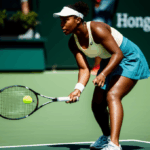The inclusion of tennis superstars like Carlos Alcaraz, Emma Raducanu, Novak Djokovic, and others in the US Open mixed doubles draw has ignited a fierce debate within the tennis community. At the heart of the controversy lies the question: are these high-profile players “taking jobs” away from doubles specialists who dedicate their careers to this discipline? Former world No. 1 Andy Roddick has weighed in on the matter, sparking further discussion about the balance between growing the game and providing opportunities for all players.
The US Open’s Doubles Shake-Up
The US Open has introduced a significant change to its mixed doubles format, scheduling the event during the qualifying week, specifically on August 19 and 20. This adjustment allows top singles players to participate as a warm-up before their main singles matches commence. While the move aims to attract more attention and excitement to the doubles circuit, it has also drawn criticism from those who believe it unfairly disadvantages doubles specialists.
The revamped draw boasts several blockbuster pairings, including:
- Carlos Alcaraz and Emma Raducanu
- Novak Djokovic and Olga Danilovic
- Jannik Sinner and Emma Navarro
- Naomi Osaka and Nick Kyrgios
These high-profile teams have undoubtedly generated buzz and anticipation among fans, promising thrilling matchups and increased viewership. However, the inclusion of these stars means that some lower-ranked doubles players, who had hoped to compete, will miss out on the opportunity.
Roddick’s Mixed Feelings
Andy Roddick, known for his candid opinions and insightful commentary, addressed the controversy on his podcast, “Served with Andy Roddick.” He acknowledged the frustration felt by doubles players who may be losing their spots to singles stars.
“Now, is it taking jobs away from doubles players who kind of run this side tour? Yeah, it is,” Roddick conceded.
However, he also emphasized the potential benefits of having big names participate in doubles.
“But, if your net, most important thing is – which is the defense that I get when people are mad at me when I talk about doubles – is, ‘We have to grow the game of doubles,’ there is not a better way to grow the game of doubles than to have the biggest stars on earth playing doubles, featured, ESPN prime time, in the lead-up to the US Open.”
Roddick’s stance reflects the complex nature of the issue. While he recognizes the validity of the concerns raised by doubles specialists, he also believes that the presence of star players can significantly boost the popularity and visibility of doubles tennis.
The Doubles Dilemma: Growth vs. Opportunity
The debate surrounding the US Open mixed doubles draw highlights a fundamental tension in professional tennis: the need to grow the sport’s audience versus the importance of providing opportunities for players at all levels.
Arguments for including star players:
- Increased viewership: High-profile players attract more fans, leading to higher television ratings and greater media coverage for doubles matches.
- Enhanced marketability: The presence of recognizable stars makes doubles more appealing to sponsors and advertisers, potentially increasing revenue for the sport.
- Elevated profile: Star players can elevate the overall profile of doubles tennis, encouraging more people to take an interest in the discipline.
Arguments against including star players:
- Displacement of specialists: The inclusion of singles stars can prevent dedicated doubles players from competing in major tournaments, limiting their earning potential and career advancement.
- Devaluation of doubles: Some argue that when singles players participate in doubles, it can devalue the discipline, suggesting that it is not as important or demanding as singles.
- Unfair advantage: Singles players may have an unfair advantage over doubles specialists due to their superior athleticism, power, and overall skill level.
The Financial Realities of Professional Tennis
To fully understand the debate, it’s crucial to consider the financial realities of professional tennis. Unlike team sports where players receive fixed salaries, tennis players primarily earn income through tournament prize money, sponsorships, and endorsements.
Prize Money Distribution
The distribution of prize money in tennis tournaments is heavily skewed towards the top players. Grand Slam tournaments offer the most lucrative payouts, with the winners of the singles events earning millions of dollars. However, players who lose in the early rounds receive significantly less, often struggling to cover their expenses.
For example, the winner of the Australian Open in 2021 singles received $2.75 million, while a player who lost in the first round received $100,000. While $100,000 may seem like a substantial amount, it often doesn’t cover the costs associated with travel, accommodation, coaching, and other expenses.
Sponsorships and Endorsements
Beyond prize money, sponsorships and endorsements play a crucial role in a tennis player’s income. Top players attract lucrative deals with global brands, earning substantial amounts by promoting products ranging from sportswear and equipment to luxury goods and beverages.
However, sponsorship opportunities are not limited to the elite. Players who build a strong personal brand and engage with their fans can also attract endorsements, providing a significant boost to their income.
The Financial Ladder
To make it professionally in tennis, players typically start at the lowest rung of tournaments, which are ITF (International Tennis Federation) events. As they accumulate points, they become eligible to play ATP (Association of Tennis Professionals) Challenger tournaments, followed by ATP 250, ATP 500, and ATP 1000 Masters events. Finally, they can compete in Grand Slam tournaments, which offer the most prize money and exposure.
Earning a Living
The financial realities of professional tennis mean that only a small percentage of players can earn a comfortable living solely from prize money. Many players rely on coaching, exhibitions, or other sources of income to supplement their earnings.
According to a 2023 report, the net pre-tax prize money for the 100th best tennis player in the world is in the range of $350,000 – $375,000 after expenses. This figure can vary depending on the player’s country of residence and the availability of other income opportunities.
The Impact on Doubles Specialists
Given the financial challenges faced by many professional tennis players, the debate over the US Open mixed doubles draw takes on added significance. Doubles specialists, who often do not have the same earning potential as singles stars, rely on opportunities to compete in major tournaments to make a living.
By including high-profile singles players in the mixed doubles draw, the US Open may be inadvertently limiting the opportunities available to these dedicated doubles players. This can have a ripple effect, potentially discouraging talented players from pursuing a career in doubles.
Alternative Solutions
To address the concerns raised by doubles specialists, several alternative solutions have been proposed:
- Increase prize money for doubles events: Boosting the prize money for doubles tournaments would make the discipline more financially attractive, encouraging more players to specialize in doubles.
- Create more doubles opportunities: Increasing the number of doubles tournaments at all levels would provide more opportunities for players to compete and earn a living.
- Implement a quota system: A quota system could be implemented to ensure that a certain number of spots in doubles draws are reserved for doubles specialists.
- Offer financial support: Providing financial support to promising doubles players could help them cover their expenses and pursue their careers.
The Future of Doubles
The debate surrounding the US Open mixed doubles draw is likely to continue, as there is no easy solution to the complex issues involved. However, by acknowledging the concerns of doubles specialists and exploring alternative solutions, the tennis community can work towards creating a more equitable and sustainable environment for all players.
Ultimately, the goal should be to grow the game of tennis in a way that benefits all stakeholders, ensuring that both singles and doubles players have the opportunity to thrive and reach their full potential. Whether the inclusion of tennis’ biggest stars will do that remains to be seen, but it has certainly sparked a conversation about the future of doubles and the opportunities available to those who dedicate their careers to it.








No Comment! Be the first one.